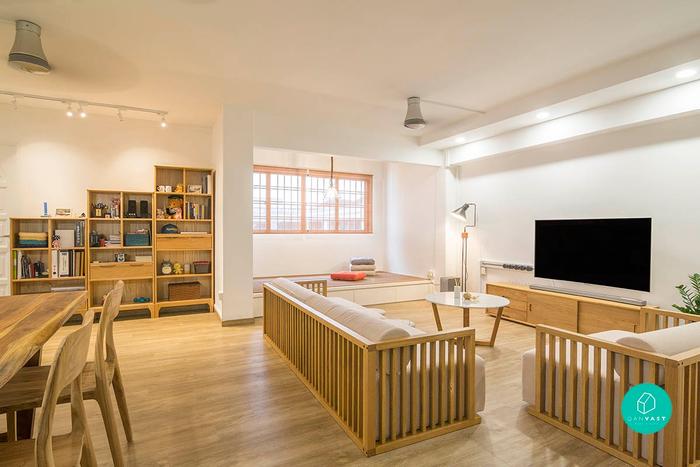The long, nerve-wrecking wait is over - your home loan has finally been approved. Phew! While that means you’re now a step closer to attaining the home of your dreams, this huge milestone also comes with its own major set of commitments – namely, loan payments every month.
Aside from taking up a huge chunk of one’s monthly expenses, these repayments also come with interest, and for these reasons it’s probably safe to say that no one enjoys being bogged down by them. That aside, what’s the best way of making these repayments? With CPF savings, cash, or a mix of both? Which is better for your financial future? Below, we answer these questions and more.

View this project by Swiss Interior Design
Should You Pick CPF or Cash?
Many Singaporeans are aware that they have the option of either using their CPF Ordinary Account (OA) savings or cash to pay for monthly home loan instalments. However, did you know that choosing the right mode of payment allows you to save more?
To start off, let’s break everything down into 3 modes: Cash only, CPF savings only, and part-cash, part CPF savings.

View this project by Weiken.com
a. First option: Cash only
Paying for your monthly instalments with just cash alone means that all future contributions to your CPF OA (20% of your monthly salary and 17% from your employer) will remain untouched.
This will help to bolster your overall savings across the years, as your CPF monies will grow with the interest paid out by the CPF Board. After your monthly CPF contributions have been distributed between your OA, Special Account (SA) and Medisave, the remaining sum in your OA will grow at a 2.5% annual interest rate.
Let’s assume you purchase a BTO flat priced at S$300,000 and take up a S$225,000 home loan (after making the 25% down payment).
- Home Loan Amount: $225,000
- Loan Period: 25 years
- Interest Rate: 1.65% per annum
- Monthly Instalment $916
In the table above, the monthly contribution of S$916 works out to S$274,800 over 25 years. If you had regularly contributed S$916 to your CPF OA instead and allowed it to compound at 2.5% p.a. over 25 years, it works out to a sizeable amount of S$382,926.71!
This difference of S$108,126.71 means you’ll be better equipped to pay off any future loans, education expenses, insurance premiums and even to invest with, thus allowing you to further grow your wealth in preparation for retirement.

View this project by Space Atelier
b. Second option: CPF savings only
If you choose to use only the funds in your CPF OA to pay off your monthly instalments, you’ll be unable to accumulate as much funds in your CPF OA at the end of the day (as compared to the first option of using just cash), because of the inability to grow your OA savings at 2.5% p.a. interest.
However, this is a wise option if you foresee a need to have more cash on hand, or if you prefer more flexibility in how you use your money. With your OA savings fully financing your monthly home loan payments, you are free to use your money for investments.
Note that you will need approval from the CPF Board to use the money in your CPF OA for home loan repayments, and there is a cap on the amount that you can use to repay your home loan.

View this project by Fuse Concept
c. Third option: Part cash, part CPF savings
This option gives you the best of worlds: on one hand you get to decide how much cash you get to keep on hand, and on the other you’ll get to accrue interest from the funds in your CPF OA. Put simply, you’ll be able to pay for monthly loan instalments, on top of having sufficient disposable cash.
But how exactly do you determine the right ratio of cash to CPF payments? Simple, just take a look at your current home loan’s interest rate.
For instance, if your current loan charges a lower interest rate of 1.75% p.a., it would be wise to fork out more cash, and tap into your CPF savings less, which will allow you to take advantage of the 2.5% p.a. interest rate on your OA.
In this case, the same reasoning applies as the first option applies here: the more money you have in your CPF OA, the better, as you’ll be able to accumulate more savings for your retirement over the same period of time.

View this project by Inzz Studio
Extra tip: Make Regular Capital Repayments to Better Manage Your Loan
Similar to the idea of overpayments, capital repayments involve paying more than what you are obliged to every month. And the advantage of doing so is that you’ll be able to reduce the overall interest payable, as such making regular capital repayments (if you have the cash to spare) will prove to be beneficial in the long run.
The process of making a capital repayment isn’t hard either – in this digital age, you can simply submit your request online with just a few clicks. Plus, you can even use cash, CPF savings, or a combination of both, just like paying off for a housing loan. Just make sure you get permission from CPF beforehand!
However, do take note of the terms of your home loan before making any capital repayments, as certain conditions may have to be met depending on your bank (e.g. a minimum repayment sum).
